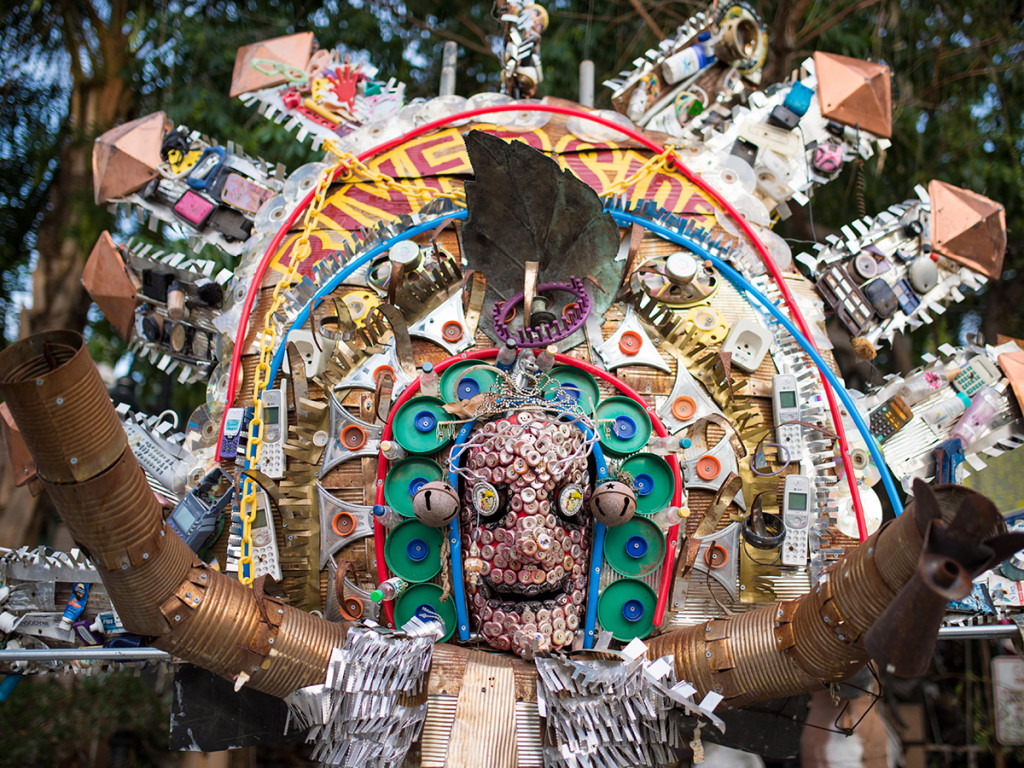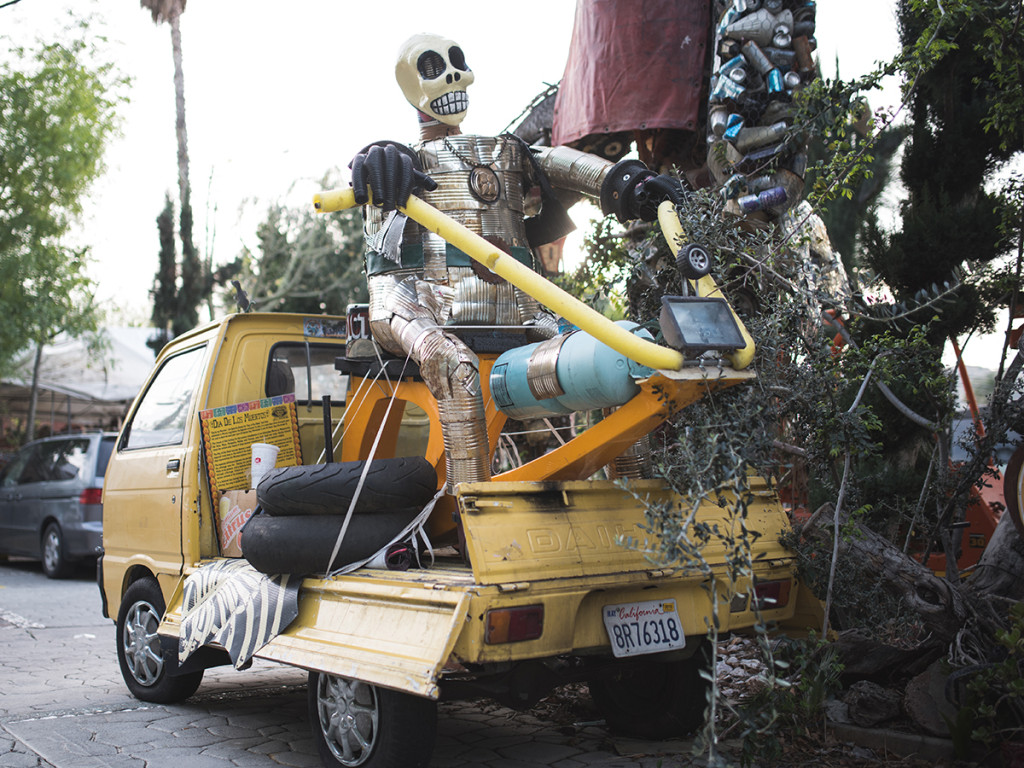
“One man’s trash is another man’s treasure.” — Proverb
Or, as Stephanie Sanchez and Kimberly “Kim” Sanchez put it, one man’s trash allows for their father, Martin Sanchez, to be a highly “organized hoarder.” Kidding aside, anyone passing by the restaurant nestled in downtown Riverside, Tio’s Tacos, can tell the father is no mere hoarder, but an artist who takes mixed media pieces to a whole new level.
To Martin, this level is not metaphorical, as I stared at up at a two-story clown formed from an assortment of cans, plastic containers and what I guess to be empty clam shells — one of the many chicken-wired held figures towering above customers as they munch on tacos or slurp at their bowl-sized margaritas.
After migrating from his home town of Sahuayo, Mexico in northern Michoacan and illegally selling tacos with a converted hot dog cart for many nights, Martin and his wife, Concepcion, established their restaurant in 1990, naming it after Martin’s nickname “tio” or “uncle” in Spanish. Now, their two daughters, Stephanie and Kim, co-run the family business they have been involved in since they were kids washing dishes in the back or helping their father with his pieces. Although it mainly serves as a restaurant, Stephanie said, “A lot of people say that name doesn’t go with the place. When you think of Tio’s Tacos, you don’t expect this,” gesturing to the figure of the Green Giant (that weird, elf-ish dude clad in leaves who appears on cans of green beans or spinach or something else gross) hanging from a cage contraption on a palm tree.
And she’s right.
Over the past 26 years, the business has greatly expanded from the original indoor space that the Sanchezes first rented to a whole backyard and their house both sisters have grown up in. Though, Concepcion and Sanchez’s daughters weren’t expecting for Tio’s to have become how it is today with old stuffed animals hanging from trees, colorful mosaics of broken tile and plates smoothed onto the floor, human-shaped figures composed of trash greeting them or a tepee water structure and a small church entirely constructed out of glass bottles.
As Stephanie said, “For us, when he would explain, ‘I’m gonna do this figure out of this,’ we really thought he was going crazy.” It was not hard to relate to her experiences as she went on to describe more instances of her father’s strange art. “He would say, ‘I’m gonna use chicken wire to form the figure and put it on the palm tree. I’m gonna do this. I’m gonna do that.’ My sisters and my mom were always like ‘Okay … We’re losing him, but let him do his thing.’”
It may have started as a hobby, but now Tio’s has an individualized, unique touch in every nook and cranny, which Riverside residents and even out-of-towners have enjoyed and frequented for years.
“It’s mind-blowing,” laughed Stephanie. “When you go and explain to somebody what Tio’s is, you can’t explain it, because it’s literally a guy who is creating something out of trash or it’s literally trash creating something.”
For visitors, Tio’s is a funky, outdoor art exhibit to walk around in with a horchata and to take in various mediums Martin has experimented with over years. For the Sanchez sisters, Tio’s is their home.
From toothbrushes, remote controls, detergent containers, old toys, makeup brushes, all the art pieces were constructed with former items and possessions the Sanchezes had in their pink house on the premises.
Kim reminisced, “When we wouldn’t want them (our toys), we would just put them aside … Even when we were still playing with them and he didn’t know, he would see it laying around and would put it in an art piece. And, then later on, we would see them and then we would say ‘We weren’t done playing with them!’”
Toward the back, the figure wearing a top hat and holding a glass bottle in a celebratory fashion consiss of miscellaneous items they played with — a “Finding Nemo” character, snappy-looking glasses and various toy cars. Next to the fancy figure is a long-haired woman … or what I assume to be a woman due to its body completely decked with Barbie dolls. Down the way, visitors can also see Stephanie’s green bike she rode during high school or the smaller one with training wheels both sisters rode as toddlers paved into a cemented walkway. Thinking and pointing out all these pieces, Stephanie mused, “If we literally want to show our childhood memories, we can go outside and point out a lot things we used.”
Although “blood, sweat, tears and layers of our life are just stacked up in here,” Stephanie pointed out that if all the pieces were torn down and thrown into a pile, it would just be trash. “The business in the beginning was not the greatest so he didn’t have a lot of money to create certain things. So, he used what he had — trash.” Yet, with time and drive, Martin made discarded items into art that encompassed his imagination and captivates Tio’s visitors. No matter the materials — or lack thereof — art can always be created as a walk through Tio’s proves time and time again.
As a fourth-year anthropology major and artist, Racheal Adair said while forking at a taco salad, “I think it’s kind of crazy that you can take all things like this and turn it into art. It’s rather inspiring.”
As a space, Tio’s allows for one to view art and to also practice it. Previous classes on painting, photography, poetry and religion have been held in the back patio; the chapel of glass bottles, which Martin constructed for Concepcion, has been used for weddings and vow renewals; the teepee is emblazoned with the symbol of Riverside’s commitment to arts and innovation often on the city’s lampposts and bridges — the raincross symbol (or, for those not familiar, it’s the thing that looks like a bell). Although it’s versatility may have not been the its original purpose, Kim said, “this place is always open to the community.”

In particular, Tio’s has held numerous events associated with Mexican-American and Mexican culture, such as quinceaneras, Dia de los Muertos and Cinco de Mayo. In honor of a tradition from the Sanchez’s hometown in Michoacan, Tio’s has played host for the Tlahualiles Festival in White Park, which is originally an annual two-week-long cultural and religious celebration. Donning elaborate masks bedazzled, feathered, painted and constructed to be several times the size of one’s head and wearing a 50-pound vest of layered sheet metal, dancers jump and jive in time to trumpets and snare drums. Foregoing the religious aspects, the festival held here instead shares the culture of Sahuayo through dance and costume. Outside of the festival, Tio’s stores the masks on its premises, allowing anyone to see the masks up close.
While I was curious to see how much the masks weighed when worn, I chickened out of asking and instead opted to walk around the backyard more.
Before leaving Tio’s Tacos, I saw one last art piece: two palm tree figures of tin cans held by chicken wire. With traffic cone noses and rusted plates of tin pants, the figures of a man and a woman held hands, while staring out to the community, Their smiles ever present.
I’m not sure what you, reader, would interpret from those figures. Maybe you’ll focus on how the man’s mustache was once part of a large broom. Maybe you’ll focus on the particular pointy-ness of the woman’s canned bosom.
I like to think of them welcoming anyone, hungry for food and art.
Racheal Adair is a contributing writer for the Highlander Newspaper.








